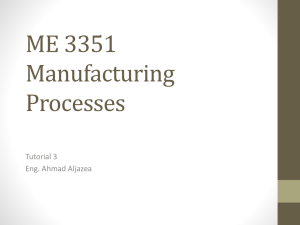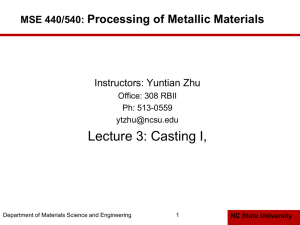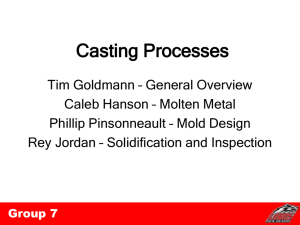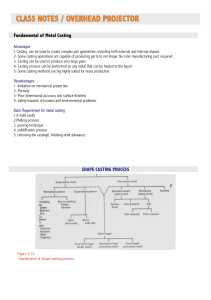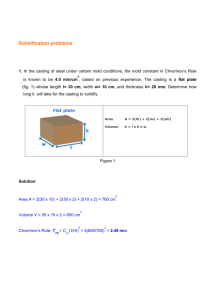Recitation Notes Topics covered October 02/03, 2003
advertisement
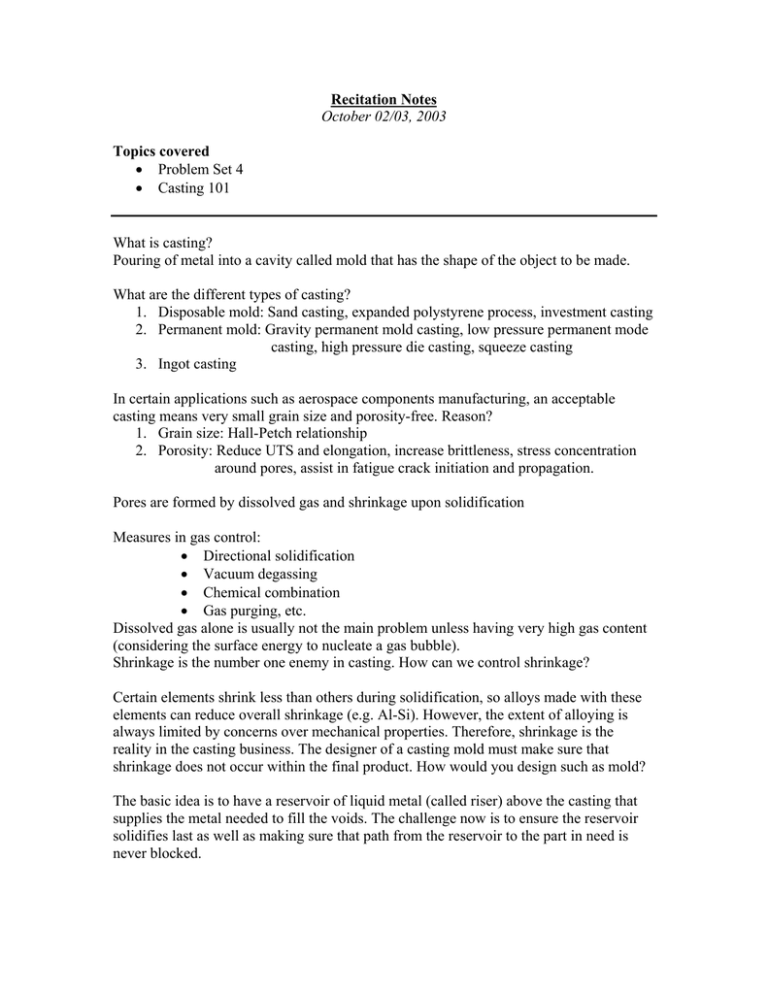
Recitation Notes October 02/03, 2003 Topics covered • Problem Set 4 • Casting 101 What is casting? Pouring of metal into a cavity called mold that has the shape of the object to be made. What are the different types of casting? 1. Disposable mold: Sand casting, expanded polystyrene process, investment casting 2. Permanent mold: Gravity permanent mold casting, low pressure permanent mode casting, high pressure die casting, squeeze casting 3. Ingot casting In certain applications such as aerospace components manufacturing, an acceptable casting means very small grain size and porosity-free. Reason? 1. Grain size: Hall-Petch relationship 2. Porosity: Reduce UTS and elongation, increase brittleness, stress concentration around pores, assist in fatigue crack initiation and propagation. Pores are formed by dissolved gas and shrinkage upon solidification Measures in gas control: • Directional solidification • Vacuum degassing • Chemical combination • Gas purging, etc. Dissolved gas alone is usually not the main problem unless having very high gas content (considering the surface energy to nucleate a gas bubble). Shrinkage is the number one enemy in casting. How can we control shrinkage? Certain elements shrink less than others during solidification, so alloys made with these elements can reduce overall shrinkage (e.g. Al-Si). However, the extent of alloying is always limited by concerns over mechanical properties. Therefore, shrinkage is the reality in the casting business. The designer of a casting mold must make sure that shrinkage does not occur within the final product. How would you design such as mold? The basic idea is to have a reservoir of liquid metal (called riser) above the casting that supplies the metal needed to fill the voids. The challenge now is to ensure the reservoir solidifies last as well as making sure that path from the reservoir to the part in need is never blocked. Sand mold - - assume uniform and constant temperature (Tm) in liquid and solid metal (heat is released during solidification); the surface of the mold has the same temperature as the liquid metal need to find thickness of solid metal, M The energy balance equation is: Heat flux through mold surface = Latent heat released during solidification ∂T dV = −ρ ∆H − kA ∂x x =0 dt ∂T dM = −ρ ∆H ∂x x =0 dt Looking at the temperature profile in the mold, it is obvious that T is an error function solution (for now assume semi-infinite mold) with boundary conditions: T ( x = −∞) = To ; T ( x = 0) = Tm −k ⎛ −x ⎞ ⎟⎟ T = To + (Tm − To )erfc⎜⎜ ⎝ 4αt ⎠ T − To ∂T = M ∂x x =0 παt remember the chain rule term! Putting back into the energy balance equation T − To dM −k M = − ρ∆H dt παt Initial conditions: at t = 0, M = 0 2k (TM − To ) 12 M = t πα ρ ∆H Therefore to prevent the reservoir from solidifying prematurely, the minimum dimension of the riser can be estimated with the solidification time of the casting. What is the minimum dimension of the mold for the solution to be valid? L2 t< → L > 4 αt 16α Is it sufficient to simply make the riser’s dimension larger than the “thickest” section of the product and avoid this calculation? Not always, because of the presence of hot spots within the mold and the casting. Can we just make a huge riser and forget about the calculation? Yes you can, but your boss will not be happy. First, the riser even with the minimum dimension is usually large. Making it any larger unnecessarily means more waste of metal and energy. Second, the larger the riser the more machining needed to be done after casting to remove the riser. How do we determine the solidification time? Experience, I guess. Investment Casting Is the solution easier or harder?


